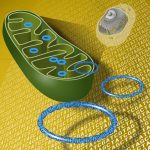Table of Contents
Definition
noun
plural: nuclear bodies
nu·cle·ar bod‧y, ˈnjuː.kli.ər ˈbɒdi
Any of the prominent non-membraned, non-chromatinic fibrillary material in the nucleus of the eukaryotic cell that includes Cajal bodies and gems, polymorphic interphase karyosomal association (PIKA) domains, promyelocytic leukaemia protein (PML) bodies, paraspeckles, splicing speckles, perichromatin fibrils, and clastosomes
Details
Overview
In eukaryotic cell, the nucleus is the organelle responsible for maintaining the integrity of DNA and for controlling cellular activities such as metabolism, growth, and reproduction by regulating gene expression. It is a double-membraned organelle containing nuclear structures, e.g. chromatin and nuclear bodies. A nuclear body refers to any of the prominent non-membraned structures in the nucleus of the eukaryotic cell.
Features
Nuclear bodies are prominent structures of non-chromatinic fibrillary material (thus, different or distinct from the chromatins that are present as well in the nucleus). They are most likely proteinaceous as they could be comprised of 53kDa protein (associated with the nuclear matrix), promyelocytic leukaemia protein (PML) antigen, sp100 nuclear antigen, etc.
Types
Nuclear bodies may be classified into simple (type I and type II) and complex (type III, type IVa, and type V). Nucleolus, the round granular structure within the nucleus of a cell, composed of proteins, DNA, and RNA, and functions primarily for the creation of ribosomes, is one of the most well-known nuclear structures. It is regarded as a type of nuclear body. Other examples of nuclear bodies are Cajal bodies and gems (Gemini of Cajal bodies), polymorphic interphase karyosomal association (PIKA) domains, promyelocytic leukaemia protein (PML) bodies, splicing speckles, paraspeckles, perichromatin fibrils, and clastosomes. Cajal bodies (0.3–1.0 µm in diameter) are nuclear bodies that resemble balls of tangled thread. The nucleus could contain one to ten Cajal bodies.1 Gemini of Cajal bodies(also called gems) derived its name from its semblance in size and shape of Cajal bodies, making them twins (Gemini). However, Gemini of Cajal bodies do not contain snRNPs (small nuclear ribonucleoproteins). Rather, they have SMN (survival of motor neuron) proteins. Furthermore, they are coilin-negative as opposed to Cajal bodies that are coilin-positive. PIKA domains whose functions are still unclear were first seen to be associated with chromatin.2 PML bodies (also referred to as nuclear domain 10 or ND10, Kremer bodies, or PML oncogenic domains) are subnuclear structures that are spherical in shape, and in mammalian nucleus, occur in ten to 30 bodies with diameters ranging from 0.3 to 1 µm.1 They are comprised primarily of promyelocytic leukemia protein (PML) (hence, the name). Paraspeckles are irregularly-shaped subnuclear structures in the interchromatin space of the nucleus with a diameter ranging from 0.2 to1 μm in size.3 Their name is derived from being often in juxtaposed with splicing speckles, another subnuclear structures in the interchromatin regions. Splicing speckles (also called nuclear speckles, nuclear specks, splicing factor or SF compartments, interchromatin granule clusters, or B snurposomes) are involved in splicing snRNPs (thus, the name). Perichromatin fibrils are subnuclear fibrils rich in RNA. Clastostomes are ring-shaped nuclear bodies whose diameter ranges from 0.2 to 0.5 µm. They are comprised primarily of ubiquitin conjugates, proteolytically active 20S core and 19S regulatory complexes of the 26S proteasome, and protein substrates of the proteasome. Their number increases during proteasomal activity.4
Biological functions
The nucleolus is involved with ribosomal RNA synthesis and the formation of ribosomes in eukaryotes. It is also functions in the assembly of signal recognition particles. Cajal bodies are involved in RNA processing, e.g. in the maturation of small nucleolar RNA and small nuclear RNA, and in the modification of histone mRNA. The gems, in turn, assist Cajal bodies in snRNP biogenesis. The function of perichromatin fibrils is not clear but they may be involved in pre-mRNA splicing and polyadenylylation. Other nuclear bodies have been observed to be involved in transcriptional activities. For instance, the nuclear dot antigen was observed to fuse with LexA DNA binding domain and activates transcription in Saccharomyces cerevisiae. Accordingly, this nuclear dot DNA antigens may be involved in the activation of transcription of specific regions of the genome in cells of yeasts and primates, including humans.5 In another study, a PLM protein was observed to suppress growth and transformation. Accordingly, the number, size, and composition of nuclear bodies are regulated in the cell cycle and some of them could be involved in the neoplasia (e.g. promyelocytic leukemia). The Sp100, in particular, seemingly has transcriptional transactivating property. The PML, in turn, apparently suppresses growth and transformation.6 Overexpression of PML was also seen to lead to programmed cell death. 7 The PML also seems to have immunologic role as it was found to inhibit the infection of vesicular virus and influenza A virus.8 Clastostome is described as a site of protein degradation.4 ND10, in turn, may be involved in chromatin regulation. 9
Supplementary
Abbreviation(s)
- NB
Synonym(s)
Further reading
See also
Reference
- Pollard, T., Earnshaw, W., Schwartz, J. & Johnson, G. (2008). Cell biology. Philadelphia, PA: Saunders/Elsevier.
- Saunders, W. S. (1991). Compartmentalization within the nucleus: discovery of a novel subnuclear region. The Journal of Cell Biology, 115(4), 919–931. https://doi.org/10.1083/jcb.115.4.919
- Paraspeckle. (n.d.). Wikipedia.org. Retrieved from https://en.wikipedia.org/wiki/Paraspeckle
- Lafarga, M., Berciano, M. T., Pena, E., Mayo, I., Castaño, J. G., Bohmann, D., Rodrigues, J. P., Tavanez, J. P., & Carmo-Fonseca, M. (August 2002). “Clastosome: a subtype of nuclear body enriched in 19S and 20S proteasomes, ubiquitin, and protein substrates of proteasome”. Molecular Biology of the Cell. 13 (8): 2771–82. doi:10.1091/mbc.e02-03-0122
- Xie, K., Lambie, E. J., & Snyder, M. (1993). “Nuclear dot antigens may specify transcriptional domains in the nucleus”. Mol. Cell. Biol. 13 (10): 6170–9. doi:10.1128/MCB.13.10.6170
- Sternsdorf, T., Grötzinger, T., Jensen, K., & Will, H. (1997). “Nuclear dots: actors on many stages”. Immunobiology. 198 (1–3): 307–31. doi:10.1016/s0171-2985(97)80051-4
- Quignon, F., De Bels, F., Koken, M., Feunteun, J., Ameisen, J. C., & de Thé, H. (1998). “PML induces a novel caspase-independent death process”. Nat. Genet. 20 (3): 259–65. doi:10.1038/3068
- Chelbi-Alix, M. K., Quignon, F., Pelicano, L., Koken, M. H., & de Thé H. (1998). “Resistance to Virus Infection Conferred by the Interferon-Induced Promyelocytic Leukemia Protein”. J. Virol. 72 (2): 1043–51. PMC 124576
- Gu, H. & Zheng, Y. (5 April 2016). “Role of ND10 nuclear bodies in the chromatin repression of HSV-1”. Virology Journal. 13: 62. doi:10.1186/s12985-016-0516-4
© Biology Online. Content provided and moderated by Biology Online Editors




